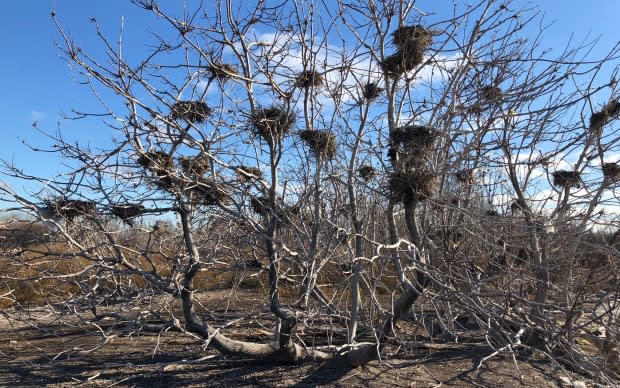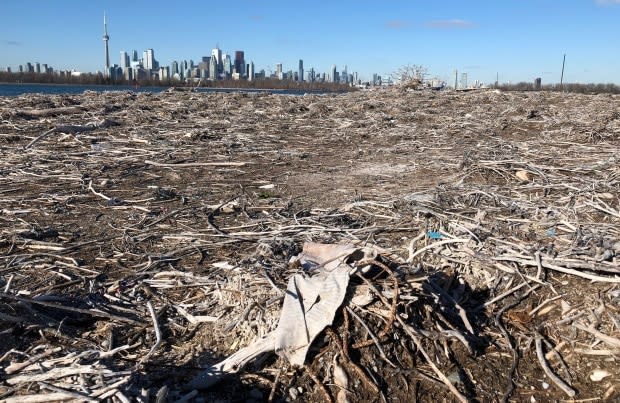Conservation groups raise concerns about Ontario hunt of cormorants this fall
Conservation groups say they are concerned about an Ontario government decision to allow a hunt of double-crested cormorants across the province this fall.
The Ontario ministry of natural resources and forestry announced the hunt on Friday, calling it a "fall harvest," and said it will allow a hunter with an outdoors card and small game licence to kill up to 15 birds a day from Sept. 15 to Dec. 31. Hunters will be allowed to shoot the birds from stationary motorboats.
According to the ministry, the rationale for the killing of the birds is that they reduce fish stocks and their droppings damage natural habitat. It says they hurt the livelihoods of commercial fishermen and property owners, hunters and anglers have all complained.
"The harvest will help address concerns about impacts to local ecosystems by cormorants, a bird that preys on fish, eating a pound a day, and that can damage trees in which they nest and roost," the ministry said in a news release on Friday.
Liz White, a director of the non-profit Animal Alliance of Canada and leader of the federally registered Animal Protection Party of Canada, said the alliance and party are opposed to the hunt.
White said the hunt is unethical because the birds are not eaten, cruel because many birds will be wounded and will suffer, and scientifically unsound because the birds do not deplete commercial fish stocks.
"The problem is that the issues that they talk about as justification for the hunt are simply not held up in science," White said.
White said cormorants are found where fish are plentiful.
"What we find out is that where there are a lot of birds, like a lot of cormorants, and other colonial nesting birds, the reason that they are there in great quantities is there is also a very healthy fish population," she said.
While cormorants do destroy foliage, with their acidic droppings, known as guano, killing the leaves of trees and changing the composition of vegetation, she said: "The question is, what difference does that make?"
White said the hunt, while "pared down" from a 2018 government plan, could devastate a recovered native wildlife species that has been driven to near extinction twice in the past 200 years.
"We know that is a perilous activity and we believe it is put forward because people don't like the birds," White said.

According to the ministry, hunters will have to have "adequate means" to retrieve any bird that is shot, including those injured, and White says it will be impossible for hunters to retrieve birds with damaged beaks and wings because of where they live. They nest on the ground or in trees on islands and peninsulas.
White said if every hunter who has a licence is allowed to take 15 birds a day and if only 20,000 do so, the population of cormorants could be wiped out. There are 197,000 holders of small game licences in Ontario.
As well, she said the ministry will not be able to enforce its own rules to control the hunt.
"It begs the question, who hold the controls?" she said.
The ministry said it and its partner agencies surveyed cormorant colonies across the Great Lakes and certain inland lakes in Ontario last year. Based on nest counts, it estimates there are a minimum of 143,000 breeding cormorants in 344 colonies.
"Combined with historical data, trends suggest that cormorant populations are increasing in Lake Ontario, Lake Erie, and Lake Superior and are stable on the St. Lawrence River and Lake Huron," it said in the news release.

Steven Price, president of Birds Canada, a non-profit charitable organization that calls itself "Canada's voice for birds," agreed with White that the hunt raises questions and concerns.
Price said the hunt is more of a cull. What the province initially planned two years ago was more widespread, of longer duration and during breeding season, he said.
"While I don't like it in particular, it's better than it was," Price said. "It's at least outside of the breeding season, which makes it consistent with all other hunts, you don't normally hunt during breeding season of an animal, and it will be outside of main cottage country time and boating."
But Price said he is concerned because the province has not specified its "conservation objective," the size of what would be considered a reasonable cormorant population.
"The question is, if it were a cull, then what is the population size that you're trying to reduce it to and how will you hire experts in order for that to happen? And that's not the case here."

The cormorant came close to being endangered over 100 years ago, when birds of all kinds were shot without any control, he said.
"Cormorants are a success story in the 100 years since then with the elimination of that kind of illegal hunting and the decline in pesticide use. The birds have come back. They have come back in large numbers. Not everyone is happy seeing these large black birds over Lake Ontario, over Lake Erie and cottage country. I happen to enjoy them. Others don't," he said.
Price agreed that some people just don't like the bird.
Ministry 'taking steps' to help hunters, anglers, fishers
The ministry, for its part, has not yet responded to an email for comment, but John Yakabuski, natural resources and forestry minister, said in the release: "We've heard concerns from property owners, hunters and anglers, and commercial fishers about the kind of damage cormorants have caused in their communities, so we're taking steps to help them deal with any local issues."
Yakabuski added: "In large amounts, cormorant droppings can kill trees and other vegetation and destroy traditional nesting habitats for some other colonial water birds, so it's critical that we take action to strike a healthy balance in local ecosystems."

Lauren Tonelli, resource management specialist of the Ontario Federation of Anglers and Hunters, said the group was pleased to hear the news of the hunt. The federation has 100,000 members, subscribers and supporters.
"We've been asking the government to do something about overabundant cormorants for almost two decades now," Tonelli said on Sunday. "We're very pleased to see that they acknowledged that overabundant cormorants is an issue and they are finally taking some initial steps in dealing with them."
But she said the scale of the hunt is not extensive, despite what animal protection groups say.
"It's a pretty minor hunt, to be honest. The season lines up with pretty much every other waterfowl species in Ontario," she said. "We really don't think that this hunt will have a huge impact on the population. We really see this as a starting point and a way to recognize that something needs to be done and it gives individuals a means to begin to reduce their own local concerns."
Toronto's Tommy Thompson Park is said to have one of the largest populations of cormorants in North America.


